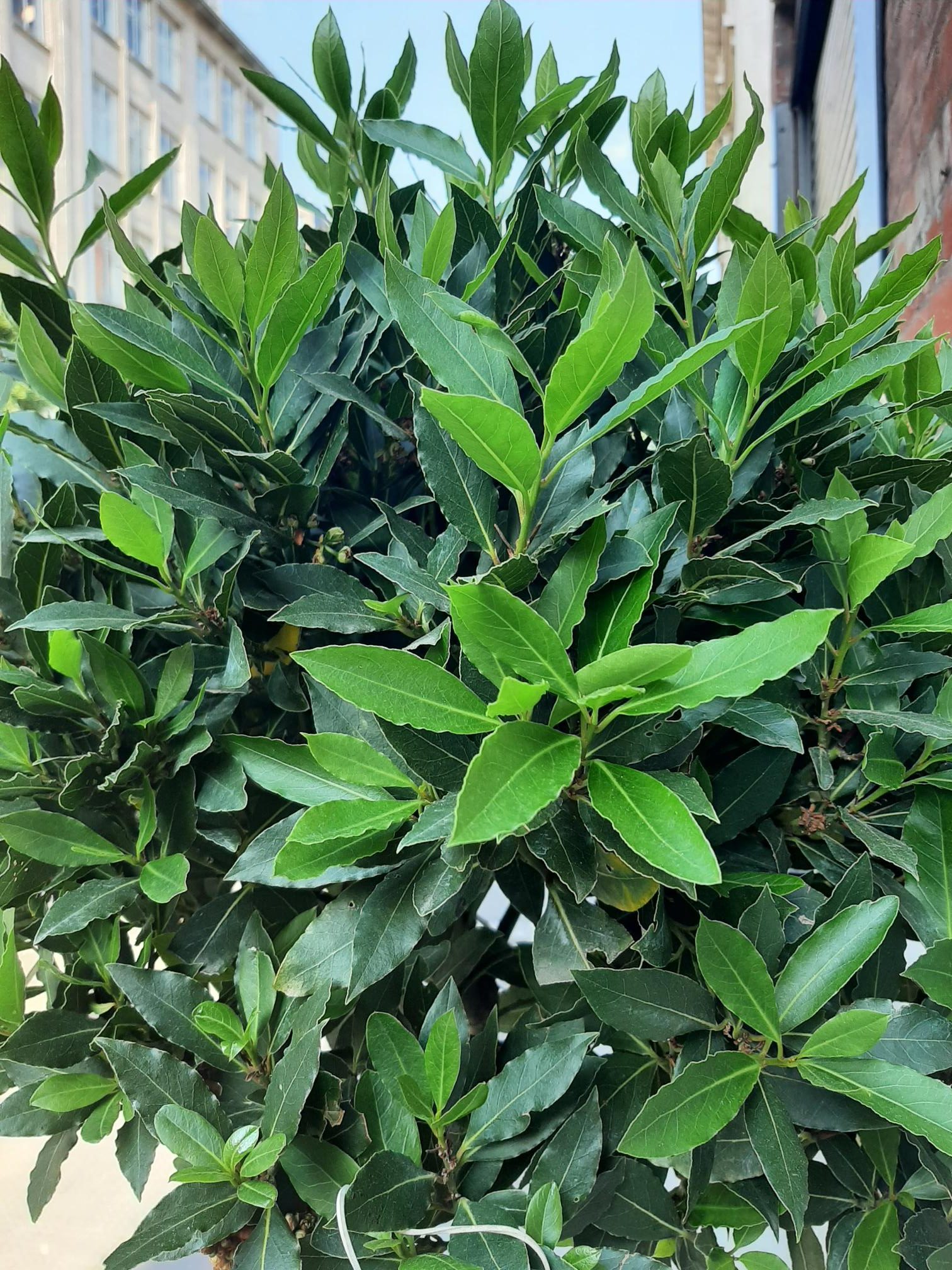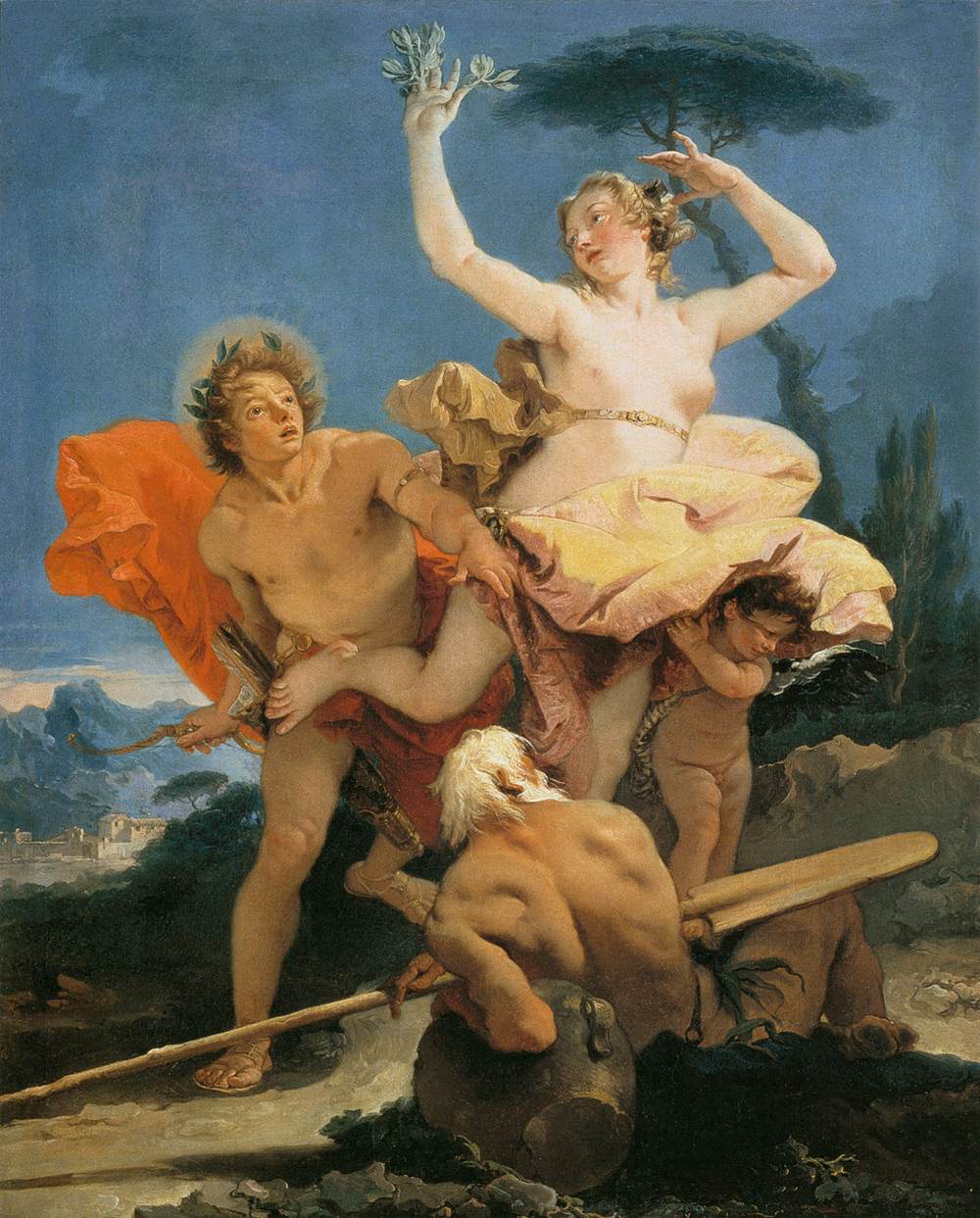THE laurel

In the UK woodland burials are now being conducted even in inner cities. There’s nothing new about this. In Greek mythology young women are always being turned into trees. One was a nymph called Daphne, who had committed herself to life-long virginity. When she was pursued by the god Apollo, she ran and ran to get away from him, and when she could run no more she cried out, ‘Oh please, let my terrible beauty be destroyed!’
“And at once she felt a heavy numbness seize her limbs. A thin bark closed over her breast, her hair turned into leaves, and her arms into waving branches. Her feet, so swift a moment ago, stuck fast in slow-growing roots, and her face was lost in the canopy. Only her shining beauty was left” (Ovid, Metamorphoses 1.252-566).
She had become a laurel tree.

Daphne escapes the clutches of Apollo. Giovanni Battista Tiepolo, 1744, The Louvre. Her fingers are already sprouting laurel leaves. Apollo looks surprised.

Daphne is the Greek word for laurel. In ancient Greece they used it to make crowns for athletes and poets. You can find many examples of this plant in Britain: outside restaurants it often takes the form of bay trees – the Laurus Nobilis, or sweet bay. Technically it’s an evergreen shrub, but if you leave it to its own devices it can grow up to 25 feet tall. So the next time you pop a bay leaf into a stew, spare a thought for Daphne, a young woman who was saved from a terrible fate, by a tree.

Daphne in my garden, 2024
green men
and women

It was only when I was creating my own Daphne in my roof garden (from a redundant shop mannequin) that I realised Daphne could be classed as a Green Woman. In this plaque, by David Lawrence, the Woman is merged with an oak-tree, and has a couple of birds nesting in her hair.

Roof boss, one of several Green Men among the sculptures of Exeter Cathedral, 13th-14th centuries
He can leer, he can grin. Sometimes he looks as if he is screaming in pain
The Green Man is a motif in art and architecture in which a face is completely surrounded by leaves sprouting from its mouth, nostrils, cheeks and chin. It is also referred to as a foliate head, and has existed in many parts of the world at many different times. Green Women are much more rare, perhaps because facial hair is rare in women.

Green Man, Chapter House, Southwell Minster, 13th century. Or is this a Green Woman? It’s worth noting that Southwell is near Sherwood Forest
Like other ancient myths, the Green Man acquired most of its meanings quite recently – in this case, in the last 100 years. Between 1890 and 1915 the anthropologist James Frazer published The Golden Bough, his massive work about the relationship between ritual and myth. This was built around the speculative idea of a pagan ritual involving a Year King, a ruler or culture hero who had to be sacrificed on an annual basis. When a new presiding spirit was installed, life in general could be renewed. This theory, incorporating the theme of death and resurrection, was very influential among writers and artists. But many people saw it as devaluing the founding story of Christianity, and for this reason it was controversial.


Roof boss, Norwich Cathedral, 14th-15th century
Julia Somerset, Lady Raglan, was one of many writers influenced by Frazer. Though she published only one article, this had considerable impact on twentieth century mythology. ‘The Green Man in church architecture’ appeared in the journal Folklore in 1939. ‘The fact is,’ Raglan writes of the mediaeval period, ‘unofficial paganism subsisted side-by-side with the official religion …’ (p.56). Buried in rites involving Morris men and May processions, she believed, is the magical rite of the spring sacrifice discussed by Frazer.
Raglan wasn’t the first person to employ the expression ‘Green Man’, but her use of it came at the right time for British folklorists.
After the Second World War people in Britain were ready for some exploration, and for some contemplation of their islands’ stories and architecture. In 1951 the first of Nikolaus Pevsner’s series ‘The Buildings of England’ was published; and in his accounts of mediaeval architecture in the subsequent 46 volumes he used the expression ‘Green Man’ culled from Raglan’s article. In the years that followed the New Age movement, neo-paganism, and environmentalism saw to it that the Green Man did not go out of fashion. New images of him proliferate on the internet, and he is probably even more popular now than he was in the Middle Ages.
Lady Raglan in 1923. National Portrait Gallery, London


Although we can speculate, we don’t know for sure what the Green Man meant to people in the Middle Ages. But gods of vegetation and fertility can certainly be found in pagan Europe; and sometimes, especially when they are wearing wreathes, they can look very like Green Men. Dionysus, the ancient Greek god of wine, theatre, and transformation in general, is often represented with a crown of vine leaves and grapes. Here he is depicted in a Roman mosaic of the third century CE, from Paphos in Cyprus. He is the greenest of all the Greek and Roman gods.

